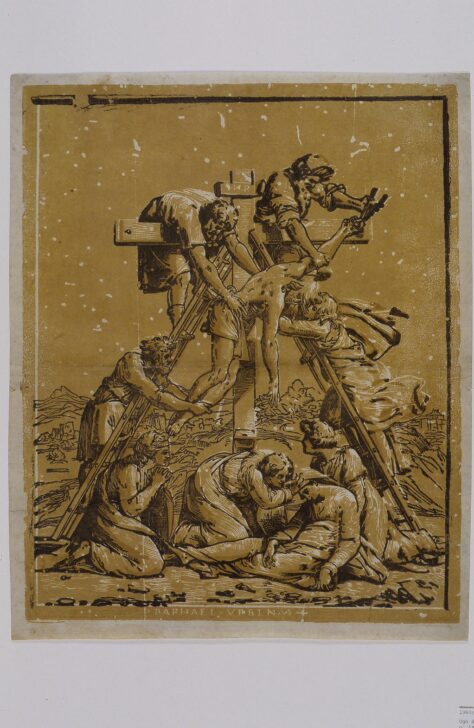Descent from the Cross
Ugo da Carpi

Description
Ugo da Carpi
Italy, circa 1480–1532
Descent from the Cross
1518–20
Chiaroscuro woodcut printed with line block and two tone blocks on laid paper
Gift of Jean Paul Slusser, 1960/1.176
After A Sibyl with a Child Holding a Torch (also on view), Ugo da Carpi continued to produce chiaroscuro woodcuts after Raphael’s drawings. The balanced, geometrical composition of Descent from the Cross clearly displays the influence of the master, whose name is inscribed along the bottom margin. The print also reveals Ugo da Carpi’s increased facility with the medium compared to his earlier efforts. He uses two tone blocks, for instance, instead of one to create shadows, and he eliminates some of the dark contour lines around the figures and the arms of the cross, relying instead upon the tones to define the forms in these areas. Although Raphael’s untimely death in 1520 cut short their collaboration, Ugo da Carpi’s prints had a lasting impact and remained in demand for centuries.
(6/28/10)
Subject Matter:
This print represents the removal of Jesus' body after his crucifixion. Four men, including Nicodemus and Joseph of Arimathea, work to lower his body from the cross. The group of mourners at the foot of the cross includes the Virgin Mary, who slumps forward in a swoon, and John the Evangelist, who supports her from behind. The balanced composition and the dignified emotional restraint of the figures in the print reveal the influence of Raphael.
Physical Description:
This print depicts the body of a man being lowered from a cross. Two men lean over the top of the cross to remove the nails from the dead man's hands and pass his body down to two other men standing on ladders. Three women and a man lay on the ground in mourning at the foot of the cross.
Usage Rights:
If you are interested in using an image for a publication, please visit https://umma.umich.edu/request-image/ for more information and to fill out the online Image Rights and Reproductions Request Form.